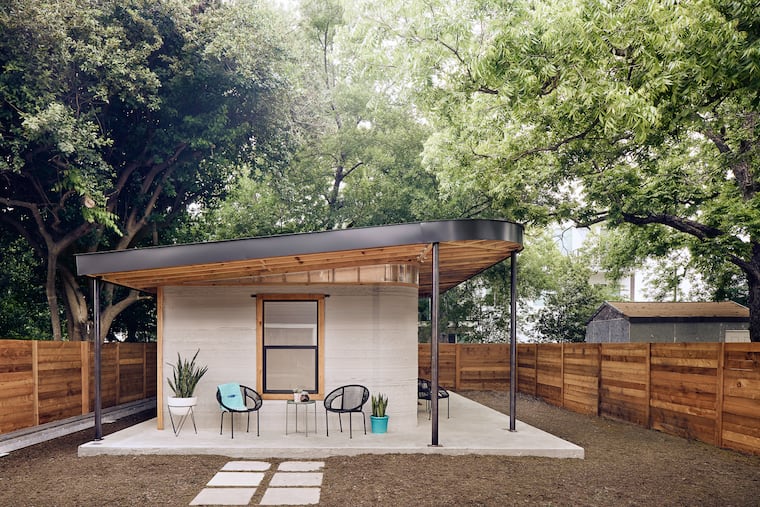In 3-D printing, one solid solution to homelessness
Austin-based construction technology company Icon has formed partnerships to explore how 3D-printed houses could not only provide housing for people on the margins but also demonstrate how to dramatically reduce the time and money spent on construction.

AUSTIN, Texas — Tim Shea is counting the days until he can move into a new 3D-printed house. Shea, 69, will be the first to live in one of six such rentals created by what some in the housing industry call a futuristic approach that could revolutionize home construction.
Shea is among a growing number of seniors in America who have struggled to keep affordable housing. He has, at times, been homeless. He has arthritis and gets around with the aid of a walker. He said he looks forward to giving up the steep ramp into the RV he’s called home.
“I’m over the top about it,” said Shea, a native of Stratford, Conn., who made his way to Austin in 1993. “They had an interview process where a bunch of people applied. Then I found out it was a 3D-printed home, and I was gung-ho.”
The promise of 3D printing has others excited, too.
The homes are taking their distinctive shape on the grounds of the Community First Village, where about 180 formerly homeless people have found shelter and camaraderie in the most expensive city in Texas. The 51-acre development (which will eventually include more than 500 houses) provides affordable permanent housing, including the 3D variety.
In this city of disrupters, Austin-based construction technology company Icon has formed partnerships to explore how 3D-printed houses could not only provide housing for people on the margins but also demonstrate how to dramatically reduce the time and money spent on construction.
“I see this innovative idea as being a powerful piece of the puzzle, along with other ideas of what it’s going to take to have more affordably built houses,” said Alan Graham, a real estate developer turned founder of the nonprofit Mobile Loaves & Fishes, which opened the village in 2016. The average age of residents is 55.
The 3D process — which incorporates an 11-foot-tall printer that weighs 3,800 pounds — relies on robotics to build the 400-square-foot houses. Beads of a pliable concrete material dubbed LavaCrete ooze from the behemoth printer in ripples that stack and harden into a wall with curved corners.
The idea is to cut the time and as much as half the cost associated with traditional construction, limit the environmental footprint, and trim the number of workers on crews, said Jason Ballard, Icon’s co-founder and CEO.
Icon has generated interest from the federal government, including NASA and the Defense Department. The Defense Department is working to develop prototype structures that can be built quickly for its military and humanitarian needs.
Ben Carson, secretary of the Department of Housing and Urban Development, visited Austin twice last year, checking out Icon headquarters and touring the village.
“The work that companies like Icon are doing," Carson said, "could have a huge impact on housing affordability in communities across the country.”
Housing is considered affordable when a resident spends 30% or less of income on it.
“While many households now of retirement age have the means to age in place or move to other suitable housing, a record number are cost burdened and will have few affordable housing options as they age,” concluded an October study from the Harvard Joint Center for Housing Studies. “In addition, many older renters are less well-positioned than homeowners because they have lower cash savings and wealth.”
The study also said homelessness among older adults is increasing. The share of people age 50 and older experiencing homelessness rose to 33.8% in 2017 from 22.9% in 2007.
Not everyone is convinced that 3D is the answer for the masses.
"Basically, 3D printing is creating a wall system," said Chris Herbert, the Harvard Center's managing director. "It still has to have a foundation. Someone needs to put on a roof. It's another way to lower the labor cost of producing components of the house, but it's not printing every piece of the house.
Architecture professor Ryan Smith, director of the School of Design and Construction at Washington State University, agrees that the technology is in its early days. “It’s worth investment and work on research in the industry, but I don’t see how it’s going to work in the current supply chain and labor market,” he said. “I personally still feel it will be 30 to 40 years before it will be having an impact.”
Brett Hagler, co-founder of New Story, a San Francisco-based social housing nonprofit to end global homelessness, is working with Icon on a 3D-printed community of 50 houses under construction in Tabasco, Mexico. New Story and Icon partnered to create the first 3D-printed structure in East Austin that debuted in March 2018 at South by Southwest.
Hagler predicted that the 3D technology "has a very real chance to usher in a quantum leap in how we build shelter.” And he’s confident that the technology will be developed beyond the current single-story detached house and provide solutions to large-scale projects.
“There’s an opportunity for a two-story. That’s going to happen,” he said. “Right now, if we can figure out a two-story, we can figure out a 10-story. It’s just a matter of time.”
Kaiser Health News is a nonprofit news service covering health issues. It is an editorially independent program of the Kaiser Family Foundation and is not affiliated with Kaiser Permanente.